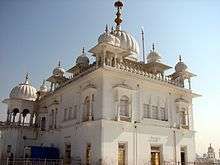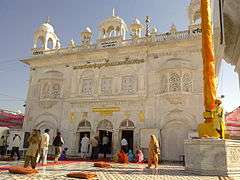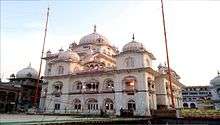Panj Takht
A takht, or taḵẖata (Punjabi: ਤਖ਼ਤ) literally means a throne or seat of authority and is a spiritual and temporal centre of Sikhism. There are five Takhts, which are five gurudwaras that have a very special significance for the Sikh community. The first and the most important was established by Guru Hargobind in 1609, 'Akal Takht' (the Throne of the Timeless God) and is just opposite the gate of Harmandir Sahib – The Golden Temple, Amritsar. While the Harmandir Sahib, or Golden Temple, represents Sikh spiritual guidance, the Akal Takht symbolizes the dispensing of justice and temporal activity. It is the highest seat of temporal authority of the Khalsa and the seat of the Sikh religion's earthly authority. There, the Guru held his court and decided matters of military strategy and political policy. Later on, the Sikh Nation (Sarbat Khalsa) took decisions here on matters of peace and war and settled disputes between the various Sikh groups. The Sarangi singers sung the ballads of the Sikh Gurus and warriors at the place and robes of honour (saropas) were awarded to persons who rendered distinguished services of the community of men in general. In December 2010, the Deccan Odyssey train, taken on charter from Government of Maharashtra, started with the aim to have a journey across four Sikh takhts, with a flight by devout and sightseers to the fifth takht (Takht Sri Patna Sahib).[1] A special train named Panj Takht Special train for the pilgrimage of five Sikh takhts, was flagged off on 16 February 2014.[2][3][4][5][6]
-Sri_Amritsar_sahib_2014-05-10_23-27.jpg)

Akal Takht Sahib
Akal Takhat Sahib means Eternal Throne. It is also part of the Golden Temple complex in Amritsar. Its foundation was laid by Guru Hargobind Ji, the sixth Sikh Guru. The Akal Takhat is situated opposite to Harmandir Sahib and is connected by a passage. The building of the Akal Takht opposite the Golden Temple has a special meaning. While the Golden Temple stands for spiritual guidance the Akal Takhat symbolizes the dispensing of justice and temporal activity. In earlier days all Sikh warriors sought blessings here before going to battle fields. During the 18th century while Sikhs were fighting a guerrilla war in the forests they used to gather at the Akal Takht on special occasions such as Vaisakhi. Here the community used to have general meetings and approve resolutions. The Akal Takht is the oldest of the Five Takhats.
Takht Sri Keshgarh Sahib

Takht Sri Keshgarh Sahib is situated at Anandpur Sahib. It is the birthplace of the Khalsa, which was founded here by Guru Gobind Singh in 1699. Some of the weapons of Guru Gobind Singh are displayed here.
Takht Sri Damdama Sahib
Takht Sri Damdama Sahib (Talwandi Sabo) is situated in the village of Talwandi Sabo near Bathinda. Guru Gobind Singh stayed here for about a year and compiled the final edition of Guru Granth Sahib also known as the Damdama Sahib Bir in 1705.
Takht Sri Patna Sahib
Takht Sri Patna Sahib is situated in Patna city which is also the capital of Bihar state. Guru Gobind Singh Ji was born here in 1666 and He spent his early childhood here before moving to Anandpur Sahib.[7][8] Besides being the birthplace of Guru Gobind Singh Ji,[9] Patna was also visited by Guru Nanak Dev Sahib Ji and Guru Tegh Bahadur Sahib Ji at different points of time. Here also stayed Guru Gobind Singh Ji's mother who is Mata Gujri Ji. In the house of salis rai jaohri.
Takht Sri Hazur Sahib

Nanded is one of the historical places in Marathwada region of Maharashtra State. It is situated on the north bank of Godavari River, in the southeastern part of Maharashtra, bordering Telangana. It is famous for Sikh Gurudwaras and is a town of great antiquity. In 1708, Guru Gobind Singh (the tenth spiritual leader of the Sikhs) came to Nanded, His permanent abode. It was He who preached amongst the Sikhs that there need not be any Human Guru for them after Him and they should take Guru Granth Sahib as their living Guru and there will be no difference between Him and the Guru Granth Sahib. A monument has been constructed at the place where Guru Gobind Singh left his body to merge with the omnipresent, known as the Angitha Sahib (funeral pyre). The Takht has been constructed around the Angitha Sahib, and is collectively known as Thakt Sachkand Sri Hazoor Sri Abchal Nagar Sahib.
References
- "A luxury train trip across Sikh takhts". December 13, 2010.
- "Singla flags off Panj Takht Special Train for pilgrims at Dhuri". Hindustan Times. February 16, 2014.
- "Now, Shatabdi to halt at Dhuri". Hindustan Times. February 9, 2014.
- "Union railway ministry: Special train to connect all five Takhats, first run on February 16 | Chandigarh News - Times of India". The Times of India.
- "IRCTC launches special train to cover all Pank Sikh Takhts". Hindustan Times. March 11, 2014.
- "Train to cover Panj Takhts from Chandigarh next week". Hindustan Times. April 11, 2014.
- Mona Mehta. "The tenth Guru was born here".
- "Five jathedars visit Patna, kick off '17 preparations | Patna News - Times of India". The Times of India.
- "Takhat Saheb set for prakashotsav | Patna News - Times of India". The Times of India.
External links
Official Website - HOLY TAKHATS

